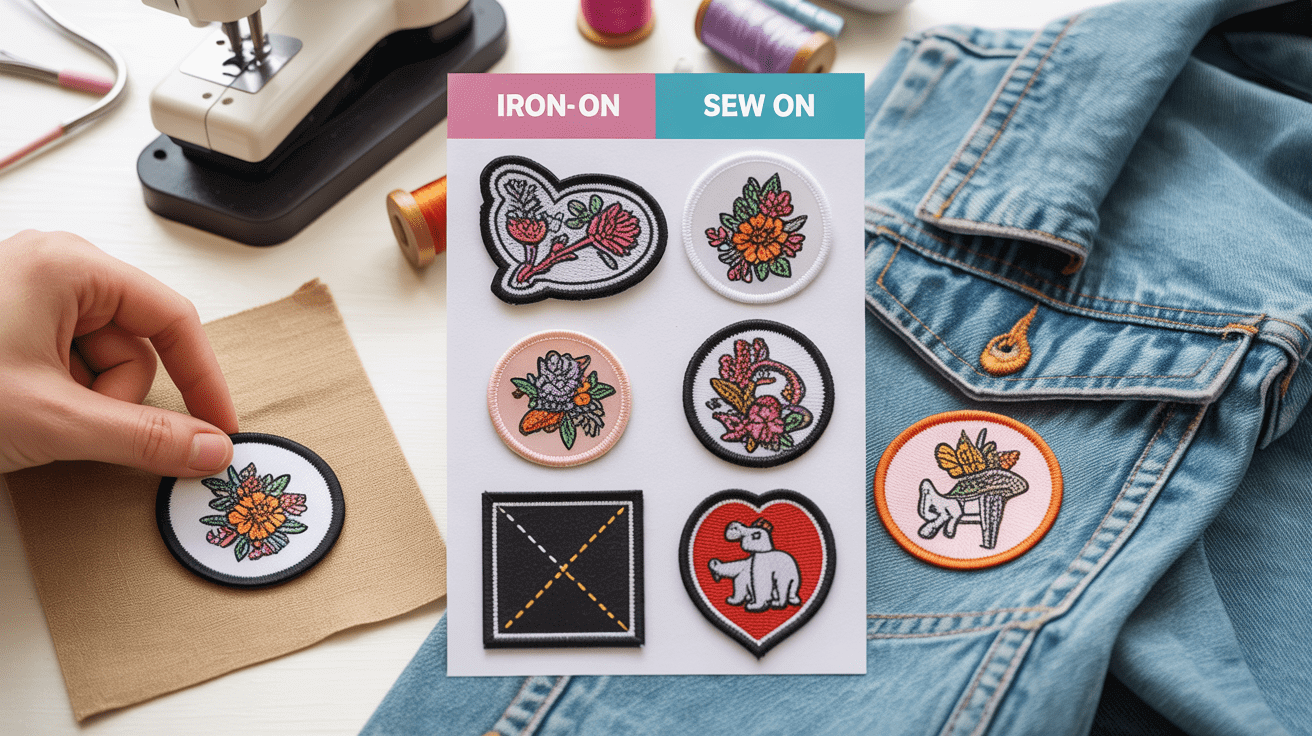How to Choose the Right Patch Backing for Your Clothes and Accessories in Canada
Patches are more than decoration . They represent identity, creativity, and style. People in Canada wear them on jackets, jeans, bags, and caps. Patches also repair torn fabric while adding character. But before you buy, you must decide on the right backing.
The two main options are iron-on and sew-on patches. Each type has strengths. Each comes with limits. Picking the right one depends on use, fabric, and lifestyle. Let’s compare both and find out which suits you best.
What Are Iron-On Patches and How Do They Work?
Iron-on patches use glue on the back. The glue melts under high heat. Once heated, it bonds with the fabric tightly. This makes them quick and easy to use. Iron-on patches are ideal for beginners. No sewing tools are required. All you need is a hot iron. They create a flat, polished look. The smooth finish works best for modern fashion.
Where to use iron-on patches:
- Denim jackets for trendy streetwear
- Jeans for personalized styling
- Children’s clothing needs quick fixes
- Caps and hats for casual looks
- Tote bags or canvas accessories
What Are Sew-On Patches and Why Choose Them?
Patches made up of fabric and have no adhesive on the backing are known as Sew-on patches they are stitched directly to the garment. You only need a thread and a needle to attach them to the fabric. Stitching holds better than glue, which is why it lasts longer.
The best example for sew-on is Custom Embroidered Patches which can be Sewn directly on the desired fabric, giving it a unique look with durability. Sew-on patches are a better option if you want patches that can withstand Canadian weather.
Where to use sew-on patches:
- Heavy backpacks and travel bags
- Sports or work uniforms
- Outdoor coats and jackets
- Items washed often
How Do Iron-On and Sew-On Patches Compare?
Comparing both helps you choose wisely. Each suits a variety of purposes. The climate, fashion, and way of life in Canada vary greatly.
Although iron-on patches save time, they are less effective in harsh environments. Sew-on patches are more labor-intensive but last longer. Here are some significant differences between them:
| Feature | Iron-On Patches | Sew On Patches |
| Durability | Weakens in snow, rain, and heavy washes | Strong in all weather, long-lasting |
| Ease of Use | Quick, needs only heat | Requires sewing tools and skill |
| Style & Finish | Flat, clean, smooth look | Stitched, rugged, visible edges |
| Best For | Fashion, light fabrics, fast updates | Outdoor gear, uniforms, frequent washes |
| Cost & Longevity | Cheaper, but short-term solution | Higher effort, but long-term savings |
| Skill Level | Beginner friendly | Needs patience and sewing experience |
This chart makes the choice clear. Iron-on patches give speed. Sew-on patches give durability.
Why Should You Pick Iron-On Patches?
Iron-on patches work best for quick fixes. They are the easiest way to refresh clothes. The flat finish looks polished on jeans and jackets.
They are also cheap and simple. Anyone with an iron can apply them. This makes them popular among beginners in Canada.
Pros of iron-on patches:
- Fast and easy to apply
- Clean and modern look
- Ideal for fashion wear
- Beginner-friendly option
- Affordable for quick updates
Cons of iron-on patches:
- Weak against cold and wet conditions
- May peel after many washes
- Not reliable on thick fabrics
Iron-on patches are perfect for style lovers. But not the best for long-term heavy use.
Why Should You Pick Sew On Patches?
Sew-on patches are the strongest choice. They withstand washing machines and harsh climates. For Canadians, this is key in the winter months.
They also offer flexibility. You can sew them by hand or machine. They are great for uniforms and outdoor jackets. They survive rough conditions without peeling.
Pros of sew-on patches:
- Long-lasting and secure hold
- Withstands frequent laundry cycles
- Perfect for outdoor gear
- Best for uniforms and bags
- Works on all fabric types
Cons of sew-on patches:
- Needs sewing tools and skills
- Takes longer to apply
- Visible stitches may not suit all looks
Sew-on patches are the reliable choice. They demand more effort but pay off in strength.
How to Apply Iron-On Patches Correctly
Iron-on patches need the right technique. A poor application can make them fall off quickly. Heat and pressure are both important. Always check the care label of clothing. Some fabrics don’t handle heat well.
Steps to apply iron on patches:
- Place the patch in position.
- Cover with a thin cloth.
- Press the iron firmly for 30 seconds.
- Allow fabric to cool before wearing.
How to Sew On Patches Properly
Patches take time to sew on. However, they remain safe for years when used properly. A sturdy stitch is crucial. Depending on your style, pick a thread color that complements or contrasts. Stitches should always be fastened at the end to avoid loosening.
Here are the steps to sew on patches:
- Pin the patch in place.
- Thread a needle with strong thread.
- Stitch around patch edges neatly.
- Tie and secure knots carefully.
Which Patch Backing Works Best in Canada?
Canadian winters are harsh. Clothes face snow, rain, and frequent washing. Each backing type reacts differently. Iron-on patches are best for short-term fashion. Sew-on patches are better for outdoor wear and long-term use.
Best for fashion jackets and jeans: Iron-on patches.
Best for outdoor and work gear: Sew on patches.
Best for saving money long-term: Sew on patches.
Adhesive glue weakens faster in these climate conditions. This is why sew-on patches remain more popular for outdoor use. They hold longer under pressure and survive better in cold.
What Type of Patch Backing Matches Your Needs?
The right choice depends on purpose. Both options can work for different situations. Many Canadians even use both methods together.
For a strong hold, you can iron on first, then stitch around the edges. This method combines neat style with lasting strength.
How to Decide Between Iron-On and Sew-On?
To decide between which one is best you need to ask yourself few questions. Your answers make the decision easier.
- Do you need quick DIY fashion? → Choose iron-on patches.
- Do you want long-lasting durability? → Choose sew-on patches.
- Do you wear outdoor gear often? → Choose sew-on patches.
- Do you want fast updates to style? → Choose iron-on patches.
FAQs
Do iron-on patches fall off after washing?
Yes, iron-on patches can loosen after many washes. Sewing them makes the patch hold stronger for longer.
Can you sew on an iron on patch?
Yes, you can sew over an iron-on patch. This gives extra strength and prevents peeling.
Which patch backing lasts longer in Canada?
Sew on patches last longer in Canadian weather. They stay secure through snow, rain, and frequent washes.
Are sew-on patches waterproof?
They are not fully waterproof but stay strong. Stitches hold the patch even when the fabric is wet.
Conclusion:
Iron-on patches are fast and stylish. Sew-on patches are durable and long-lasting. Both serve different needs and situations.
At Patch Makers Canada, we design premium-quality patches. Our products handle Canadian weather and frequent use. We offer both iron-on and sew-on options. Every patch is crafted for style and durability.
When you shop with us, you get reliability. You get long-lasting quality and identity. Upgrade your jackets, jeans, and bags with quality, style and confidence.




